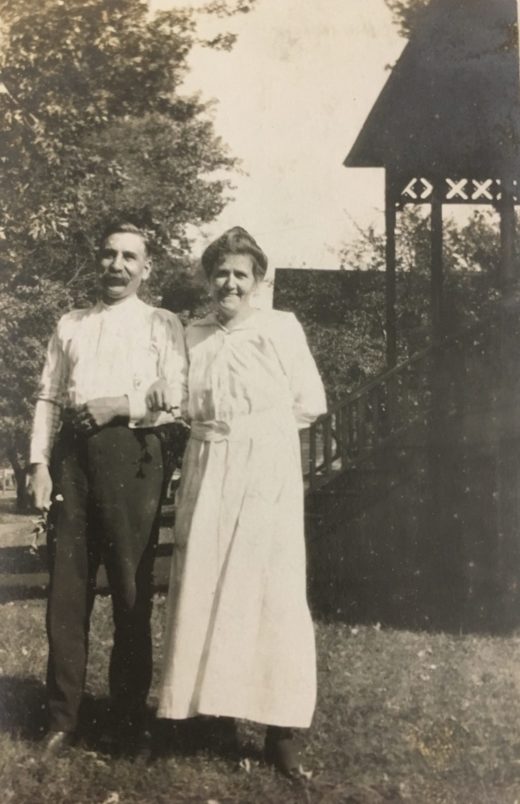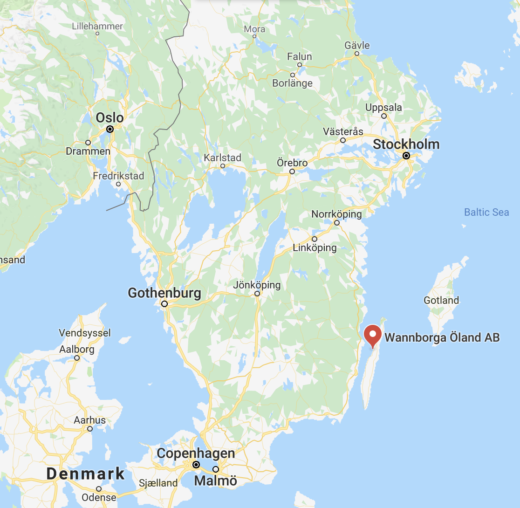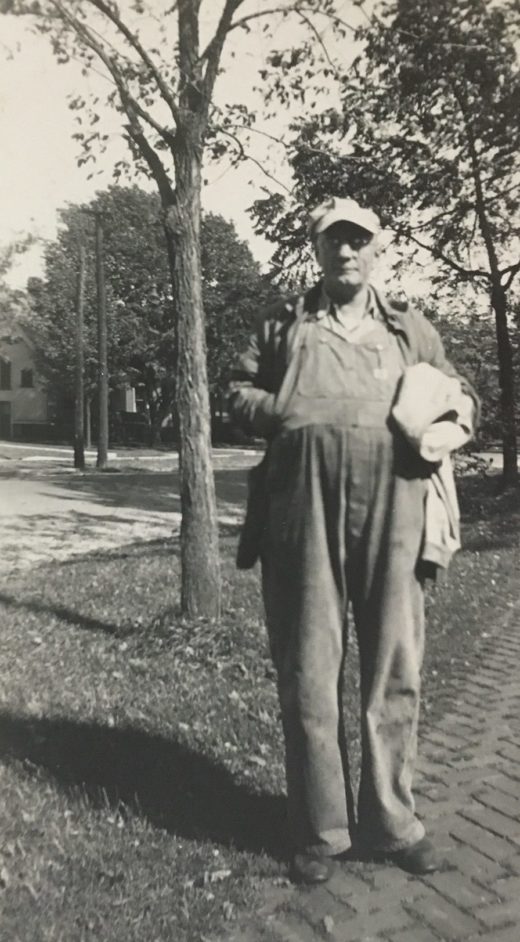The response to yesterday’s post about my familial connection to the Swedish expatriate community of Galesburg was so overwhelmingly positive that I thought I’d spend a little more time in the archives this evening and share a few more facts about my immigrant family’s past in Illinois.
First, I should correct something that I said yesterday. I said that my Swedish great-great grandfather, who lived in Galesburg, was named August Jacobson. His actual name, however, was Johann August Jakobsson. “Jacobson” was just the Americanized version of the family name. [I’m told that he also went by Gus, and not August.] Here’s a photo of my great-great grandfather enjoying life in the Swedish expatriate paradise of Galesburg, Illinois with my great-great grandmother, Anna Gustafa Nilsson Jacobson. [I’m assuming that her married name was Jacobson, as they married in the United States, after August had changed the family surname, but I’ve never seen their marriage certificate. I suppose it could say Jakobsson, but I think it’s unlikely.]
[My grandmother told me that her parents cracked eggs in their coffee, spoke Swedish around the house, baked their asses off every weekend, and feasted on eels over the holidays.]
Johann August Jakobsson was born November 23, 1870 in Ovra Wannborga, on the island of Öland, to a family of farmers. [Öland, which you can see below, is the second largest of the Swedish islands, and the smallest of the traditional provinces of Sweden. I’m told that, as of 1992, the farm was still in the family, operated by a Leif Jakobsson.]
[I was told by a Swedish acquaintance a few years ago that it totally made sense that my ancestors in Galesburg had a fondness for the taste of eel flesh, as the creatures are known to follow a migration path that takes them around the island of Öland.]
Well, my great-great grandfather left the island of Öland, and immigrated to Galesburg in April, 1897. And Anna Gustafa Nilsson, his wife, and my great-great grandmother, who was born in Dahlsland, Sweden on May 19, 1871, left her homeland four years later, arriving in the United States May 18, 1891. Anna, I should also note, was August’s second wife in America, having lost his first wife to illness shortly after they were married, and before they had any children. [I can remember my grandmother telling me that her father stayed close with his first wife’s parents, who also lived in Galesburg. She said they were like grandparents to her.]
On the subject of untimely death, it’s also worth nothing that August was not the only member of the Jakobsson family to immigrate to America. my great-great grandfather’s brother, J. Emil, also came to Galesburg, but was killed at the age of 23, while working on the railroad. [I’ve never been, but I’m told that he’s mentioned my name in the Galesburg railroad museum.]
Galesburg, I should note, as it was the first major stop for trains leaving west from Chicago, is a big railroad town. [My grandmother’s sister, Marilyn, says that she can remember going to the depot to see the first Zephyr to ever run out of Chicago.] In fact, as I understand it, Galesburg has, or at least had, one of the nation’s largest “hump yards,” where train cars are moved between tracks, and routed to their final destinations. As I understand it, a huge percentage of trains were sent from Chicago to Galesburg, about 200 miles to the northwest, and that’s where they were they were rerouted to wherever it was that they were going. And, as a result, a lot of people in Galesburg worked for “the railroad,” which, in those days, meant the Chicago, Burlington and Quincy Railroad (CB&Q).
Among my family members to work for the CB&Q was my great-great grandfather, who, according to what I’ve heard, went out on strike in the early 1900s, and never returned to the railroad. [He eventually found work at a manufacturing plant where my grandmother would eventually got a job in the office. And, after that, he started working for the water department in Galesburg.]
My great grandfather, John Lambie, the Scotsman who married Violet, the daughter of Anna and August, also worked for the railroad in Galesburg. Here he is heading to work. [He came to America as a child with his parents.]
Again, I don’t imagine this going to be of interest to anyone that I’m not related to, but, really, I’d much rather write about this than the current state of our nation.















6 Comments
Well, I found these two posts interesting and a welcome diversion from the world disintegrating around us. Thanks for sharing.
Aloha, there are so many cool things about Galesburg. The inventor of the Ferris Wheel comes from Galesburg. The Marx Brothers got there nick names there when performing at the local vaudeville theater. Carl Sandburg was born there, and Ronald Reagan attended grade school. The author of “Civic Biology” the text book involved in the Scopes Monkey Trial was a professor at the local college. And to top it all off, it was a Swedish haven.
It looks like it would be a fun place to spend a couple of days, particularly in June when they have there Railroad Days festival.
https://en.wikipedia.org/wiki/Galesburg,_Illinois
One hopes your family did not lose anyone 1,500 years ago, on Oland, at the Massacre of Sandby Borg.
From Archaeological Institute of America:
Read more:
https://www.archaeology.org/issues/207-1603/features/4158-sweden-sandbyborg-massacre
Meta, sounds like those Sandby Borgers should have been getting gunned up for defense against those axe murdering fascists. The more things change, the more they stay the same!
Hi Mark. Liz is writing a lot of our “remembering”and will send it to you. t was good to think about years ago and Galesburg. If you have any questions let us know. Hi to your family.
Hi Mark, Mom says, Anna came from Sweden to the USA to her brother Axel’s (Nilsson sp?) home in Galesburg, to help care for the family. Axel and his wife Betty had two boys and a girl.
We’re getting confused about something in the paragraph about August’s first wife. Marilyn remembers her extra grandparents as being, “Grandma and Grandpa Davis”, the parents of John Lambie’s first wife, Etta Davis. Etta died having had no children with John. The Lambie family used to walk over to the Davis house quite often for Sunday visits, etc. Etta had a brother Jeff, and perhaps Jeff had two boys that ran an office supply store east on Main Street.
So the confusion comes from August having a first wife that died before he married Anna. Marilyn does not remember that August had a first wife, but remembers the “Grandma and Grandpa” story from John Lambie’s first wife.
Yes, Aunt Rachel (John Lambie’s sister) took Marilyn to see the Zephyr come through Galesburg for the first time. She remembers it, and a lot of people being at the station to see it. The Galesburg Railroad Museum is a really cool museum because it has a lot of old records for events and people. Last time we were there we saw many familiar names listed; Jacobson, Stablein, and Harshbarger, too. And at the museum is a steam engine that you can walk through, very cool.
Mom says Galesburg had one of the nation’s “single hump yards”, meaning that it could only reroute one train at a time, but you’re right it was a big deal.
Yes, John Lambie was working for the railroad later in life. He worked nights as a Station Master, came home one day and had a heart attack. Violet came home at noon for lunch from her work as a Court Reporter, and discovered his body. Before the railroad job he managed a small factory, owned by the Darling family. It folded during the depression, odd jobs ensued until the railroad job came through. Mom remembers the hard times financially, I’m sure Dorothy had stories as well. Mom remembers her dad as being very bright, smart, though somewhat defeated by the Depression, as I am sure most people were, Mom says “everybody suffered.”
We have visited Galesburg many times over the years, though not recently. Each summer when we were kids we would pile into the car, maybe even more that once a summer. Every other summer we would visit Lexington with Grandma Violet. We have some great pictures of your parents from the “big hair” days!
Thanks Mark! We love talking about Galesburg, and this type of reminiscing we can do virtually, which is our new normal. Especially as the months will be getting colder we can send pictures that we find, and I may even have an audio tape or two of your Grandma with my mom. Love you Mark, if you don’t mind me saying so on your blog! Best to you all!
LIz